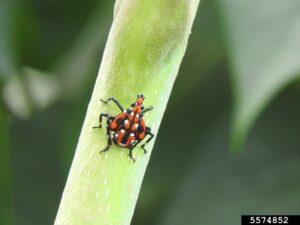Poolside Pests, Invasive Species to Look Out For
go.ncsu.edu/readext?798904
en Español / em Português
El inglés es el idioma de control de esta página. En la medida en que haya algún conflicto entre la traducción al inglés y la traducción, el inglés prevalece.
Al hacer clic en el enlace de traducción se activa un servicio de traducción gratuito para convertir la página al español. Al igual que con cualquier traducción por Internet, la conversión no es sensible al contexto y puede que no traduzca el texto en su significado original. NC State Extension no garantiza la exactitud del texto traducido. Por favor, tenga en cuenta que algunas aplicaciones y/o servicios pueden no funcionar como se espera cuando se traducen.
Português
Inglês é o idioma de controle desta página. Na medida que haja algum conflito entre o texto original em Inglês e a tradução, o Inglês prevalece.
Ao clicar no link de tradução, um serviço gratuito de tradução será ativado para converter a página para o Português. Como em qualquer tradução pela internet, a conversão não é sensivel ao contexto e pode não ocorrer a tradução para o significado orginal. O serviço de Extensão da Carolina do Norte (NC State Extension) não garante a exatidão do texto traduzido. Por favor, observe que algumas funções ou serviços podem não funcionar como esperado após a tradução.
English
English is the controlling language of this page. To the extent there is any conflict between the English text and the translation, English controls.
Clicking on the translation link activates a free translation service to convert the page to Spanish. As with any Internet translation, the conversion is not context-sensitive and may not translate the text to its original meaning. NC State Extension does not guarantee the accuracy of the translated text. Please note that some applications and/or services may not function as expected when translated.
Collapse ▲Pool owners, be on the lookout when cleaning your filters this summer. What are you looking out for? Spotted Lanternfly and Asian Longhorn Beetle. These two invasive pests have been spotted in neighboring states. Spotted Lanternfly has active populations in Northern Virginia and Asian Longhorn Beetle has a confirmed population on the coast of South Carolina. Please continue reading to see what these pests look like and why they are such a threat.
Spotted Lantern Fly feeds on the sap of many species including, grapes, hops, apples, birch, tree of heaven, maple, poplar, and more. They are able to spread quickly and create a large amount of honeydew, which can produce black sooty mold on plants and objects around those plants. The two stages you would see here in the summertime are pictured below.
Read more about the Spotted Lanternfly

Spotted Lantern Fly Adult ( Image: Lawrence Barringer, Pennsylvania Department of Agriculture, Bugwood.org)
Asian Longhorn Beetle adults are not a threat but the adult life stage will most likely be a homeowner’s only way to identify the presence of the beetle. The larvae of this beetle will bore into hardwood trees and will eventually result in the death of the tree. The beetle feeds on 29 species of hardwoods but prefers maple trees. With North Carolina being home to many important hardwood species it is pivotal that North Carolinians be on the lookout for this beetle to preserve our forest.
Read more about the Asian Longhorn Beetle
If you are a pool owner or just spot one of these pests in your everyday activities please contact us at N.C. Cooperative Extension in Gaston County and we can help you confirm the sighting, and help you in reporting it. You can also learn how to properly identify these pests and report a sighting at Poolside Pests.






